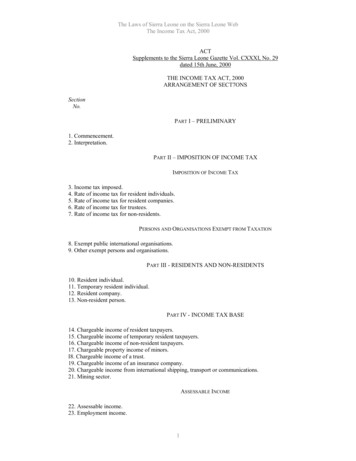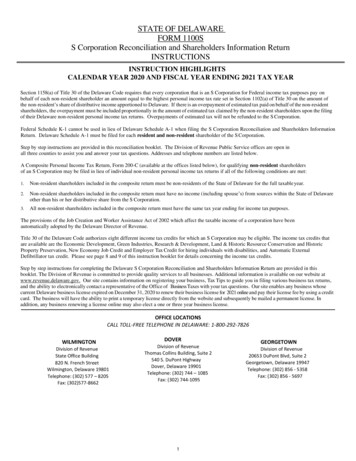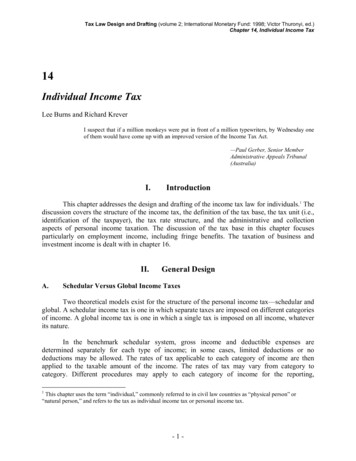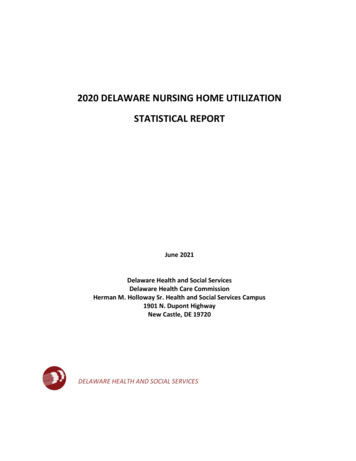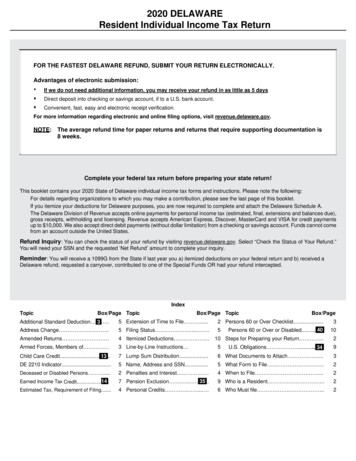
Transcription
2020 DELAWAREResident Individual Income Tax ReturnFOR THE FASTEST DELAWARE REFUND, SUBMIT YOUR RETURN ELECTRONICALLY.Advantages of electronic submission: If we do not need additional information, you may receive your refund in as little as 5 daysDirect deposit into checking or savings account, if to a U.S. bank account.Convenient, fast, easy and electronic receipt verification.For more information regarding electronic and online filing options, visit revenue.delaware.gov.NOTE:The average refund time for paper returns and returns that require supporting documentation is8 weeks.Complete your federal tax return before preparing your state return!This booklet contains your 2020 State of Delaware individual income tax forms and instructions. Please note the following:For details regarding organizations to which you may make a contribution, please see the last page of this booklet.If you itemize your deductions for Delaware purposes, you are now required to complete and attach the Delaware Schedule A.The Delaware Division of Revenue accepts online payments for personal income tax (estimated, final, extensions and balances due),gross receipts, withholding and licensing. Revenue accepts American Express, Discover, MasterCard and VISA for credit paymentsup to 10,000. We also accept direct debit payments (without dollar limitation) from a checking or savings account. Funds cannot comefrom an account outside the United States.Refund Inquiry: You can check the status of your refund by visiting revenue.delaware.gov. Select “Check the Status of Your Refund.”You will need your SSN and the requested ‘Net Refund’ amount to complete your inquiry.Reminder: You will receive a 1099G from the State if last year you a) itemized deductions on your federal return and b) received aDelaware refund, requested a carryover, contributed to one of the Special Funds OR had your refund intercepted.IndexTopicBox/Page TopicBox/Page TopicBox/PageAdditional Standard Deduction .35 Extension of Time to File .2 Persons 60 or Over Checklist .3Address Change .5 Filing Status . . .540Persons 60 or Over or Disabled. .10Amended Returns 4 Itemized Deductions . .10 Steps for Preparing your Return .2Armed Forces, Members of 3 Line-by-Line Instructions 5.U.S. Obligations .349Child Care Credit.137 Lump Sum Distribution.6 What Documents to Attach .3DE 2210 Indicator.5 Name, Address and SSN.5 What Form to File . .2Deceased or Disabled Persons .2 Penalties and Interest . . .4 When to File .2Earned Income Tax Credit.14.357 Pension Exclusion . . . .9 Who is a Resident . .2Estimated Tax, Requirement of Filing.4 Personal Credits . . .6 Who Must file . .2
Form 200-01RESIDENT INDIVIDUAL INCOME TAX RETURNWho Must File1.If you are a Full-Year Resident of the State, you must file atax return for 2020 if, based on your Age/Status, your individualadjusted Delaware gross income (AGI) exceeds the amountshown below.Filing Status1&523&4Filing StatusMarried filingjointMarried filingseparateAGE/STATUSClaimed as adependent onanotherperson’sreturnUnder 60 9,400 15,450 9,400 5,25060 to 64** 12,200 17,950 12,200 5,25065 and overOR BLIND** 14,700 20,450 14,700 7,75065 and overAND BLIND** 17, 200 22,950 17,200 10,250*This dollar amount represents your individual Adjusted Gross Income, NOT a totalcombined with anyone else.**Assumes only one spouse meets age or blindness criteria.2.If you were a Part-Year Resident, you must file a Delaware taxreturn:c.If you had income from any source while a resident ofDelaware, ord.If you had income from a Delaware source while you were anon-resident of Delaware.Part-year residents may elect to file either a resident or nonresident return. You may wish to prepare both. File only the returnwhich is more advantageous for you.Part-Year Residents electing to file a resident return – this option maybe advantageous if, during the period of non-residency, you had noincome from sources in other states and/or your only income was fromDelaware.Part-Year Residents electing to file a non-resident return – This optionmay be advantageous if, during the period of non-residency, you hadany income from other states or sources outside of Delaware. Pleaserefer to the instructions for Form 200-02 to review this option.Note: Volunteer Firefighter, Child Care and Earned Income TaxCredits cannot be taken on the non-resident return (Form 200-02).3.If you are a Non-Resident who had gross income in 2020 fromsources in Delaware, you must file a Delaware Tax return.What Form to FileFull-year residentsPart-year residentsNon-residentsWho is a ResidentA resident is an individual who either: Is domiciled in this State for any part of the taxable year; or Maintains a place of abode in this State and spends more than183 days of the taxable year in this State.A domicile is the place an individual intends to be his permanent home;a place to which he intends to return whenever he may be absent. Anindividual can have only one domicile. A domicile, once established,continues until the individual moves to a new location and exhibits abona fide intention of making it his or her permanent home.Page 2GENERAL INSTRUCTIONSFull-Time Students with a legal residence in another state remainlegal residents of that state unless they exhibit intentions to makeDelaware their permanent residence.NOTE*: Foreign Travelers – If you were out of the United States forat least 495 days in the last 18 consecutive months and (at the sametime) you did not maintain a permanent place of abode in this State atwhich you, your spouse, your children or your parents were present formore than 45 days, you are not considered a resident of this State.*The above NOTE does not apply to members of the Armed Forces,employees of the United States, its agencies, or instrumentalities.Minors - Disabled - Deceased TaxpayersIf an individual is unable to file a return because he is a minor or isdisabled, the return shall be filed by his authorized agent, guardian,fiduciary or the person charged with the care of the person or propertyof such individual. See the federal Form 1040 instructions for thoseauthorized to sign. If an individual is deceased, his final return shall befiled by his executor, administrator or other person responsible for theproperty of the decedent. Please see Deceased on Page 12 for furtherinstructions on deceased taxpayers.When to FileIndividual income tax returns are due on or before May 17, 2021,for all taxpayers filing on a calendar year basis. All others must fileby the last day of the fourth month following the close of their taxableyear.Extension of Time to File a ReturnCAUTION:THERE IS NO EXTENSION OF TIME FOR PAYMENT OF TAXAn extension of time to file your tax return is granted when theApplication for Automatic Extension (Form 200EX) is filed prior tothe due date of your return. Interest accrues on any unpaid tax at arate of ½% per month, or fraction of a month, from the return’soriginal due date until paid.To extend your due date for submitting your completed income taxreturn (from May 17, 2021 to October 15, 2021) submit the following tothe Division of Revenue no later than May 17, 2021:1. The completed copy of Form 200EX; and2. Your payment of any balance of tax liability estimated to be due fortax year 2020.The application for an automatic extension, Form 200EX, may befiled on-line at our website at revenue.delaware.gov. If you owe taxwith your extension for 2020 and file on-line, you may use a directdebit from your checking or savings account or pay by credit card.If you are paying by direct debit you may specify a later payment date,up to the due date. Payments by direct debit must not come from anaccount outside the U.S. and may be made in any amount without dollarlimitation. Payments up to 10,000 can be made by credit card. If youchoose not to file online, a blank copy of Form 200EX is available fromthe Division of Revenue or from our website.Blanket requests for extensions will not be granted. YOU MUSTsubmit a separate extension request for each return.Steps for Preparing Your ReturnStep 1Complete your federal income tax return and any other state return(s).They will be used in preparing your Delaware return.Step 2Fill in the top boxes on the front of the form (name, address, filing status).See page 5 of this booklet.
Step 3Using the line-by-line instructions, first complete all lines relevant to yourreturn in Sections A, B, and C on the back of the form; then completethe front of the return.Members of Armed ForcesWhile you are stationed in Delaware, your military and non-military payis subject to Delaware state income tax as follows:Step 4When you are finished, attach the appropriate documents to yourDelaware return. See “What Documents to Attach” on this page.Step 5Sign, date, enter your phone number, and send Form 200-01 alongwith all required attachments to the applicable address listedbelow. If the return is prepared by a paid preparer, the paid preparermust also sign the return.NOTES: The return is not complete unless it is signed and dated. If filing a joint return or a married combined separate return, bothspouses must sign the return. In order to aid in timely processing of your return, please includea telephone number where you can be reached during normalworking hours. Each preparer is responsible for including all relevant items aboutwhich he/she has information. Separate filers MUST submit their returns in separateenvelopes. Please DO NOT include duplicate copies of aspouse’s return.What Documents to AttachAttach the following documents to your Delaware return:1. DE Schedule I, II and III, if completed.2. W-2 Form(s) issued by your employer and all 1099R forms toreceive credit for Delaware tax withheld.3. A copy of Page 1 and Page 2 of your Federal Form 1040 andsupporting 1040 schedules (1,2,3,4, etc.)4. A copy of all federal schedules you are required to file with yourfederal return (for example, Schedule C, D, E, F, etc.).5. A copy of Federal Schedule EIC – Earned Income Credit.6. Delaware Schedule A (PIT RSA), if you claim itemized deductions.7. A signed copy of other state’s income tax return(s) if you claim acredit for taxes paid to another State. Do NOT use the amount fromyour W-2 form(s).8. A copy of Federal Form 2441, if you claim a credit for Child andDependent Care expenses.9. A copy of Form 1100S, Schedule A-1, if you claim a credit for taxespaid by an S Corporation.10. Form DE2210, pages 1 and 2, if you completed Part 3 of theDE2210 or if the calculated estimated tax penalty is greater thanzero.11. Form 700, Delaware Income Tax Credit Schedule and Form1801AC and/or Form 2001AC, if applicable. See Pages 7 and 8 fora description of the Form 700 Credits.12. A copy of Form 5403, Real Estate Tax Return, if you declared andpaid estimated taxes on the sale of real estate owned in Delaware.Members of the Armed ForcesAre youa LegalResident ofDelaware?Delaware Filing RequiredMilitary ActiveDuty IncomeOther IncomeEarned in DEOther IncomeEarned in OtherStatesYesYes*Yes*Yes*NoNoYes*No*Whether you are stationed in Delaware or not.Your state of legal residence is the same as it was when you enteredthe Armed Forces unless you voluntarily changed it while in the ArmedForces. For example, if you were a legal resident of Delaware when youentered the Armed Forces, you remain a legal resident of Delaware forDelaware state income tax purposes unless you voluntarily abandonedyour Delaware residency and established a new legal domicile inanother state.If you change your legal residence, in the year you change, you area part-year resident of both states. A change in legal residence isdocumented by filing DD Form 2058 and DD Form 2058-1 with yourmilitary personnel office.The following examples illustrate this:1. Airman John Green, who is a legal resident of Delaware (domiciledin Delaware), was ordered to duty in, and moved his family to, NewJersey. The family has no income other than Green’s military pay.Airman Green will file a federal and Delaware Resident tax returnonly. A New Jersey state tax return is not required.2. Sergeant Paul Smith, whose domicile is Ohio, to which he is liablefor income taxes, has been on active duty in Delaware for 12months. Sergeant Smith is single and has non-military income fromDelaware. Sergeant Smith will file as a non-resident of Delaware(using Form 200-02 NR) reporting all his income in Column A. Hewill deduct his military compensation from his Delaware NonResident Return as a federal adjustment to gross income. (ColumnA, Line 16.) Sergeant Smith should contact Ohio for his filingrequirements for Ohio.Military SpousesAll income of a non-military spouse is taxed in the state of theirlegal residence. The following examples illustrate this:1. Airman Dan Brown and his spouse are legal residents of Delaware(domiciled in Delaware). Airman Brown was ordered to duty in, andmoved with his spouse to, New Jersey. Besides Airman Brown’smilitary pay, his spouse has New Jersey source wages. AirmanBrown and his spouse will file both a federal and Delaware Residenttax return reporting both military and nonmilitary income. A NewJersey state tax return is not required.2.NOTE: Failure to attach the above required documentation maydelay the processing of your return.Sergeant Michael Jones, whose domicile is not Delaware, has beenon active duty in Delaware for 12 months. Sergeant Jones ismarried and his spouse has non-military income from Delaware. IfSergeant Jones’ spouse maintains a legal residence in a stateIf Enclosing Payment w/Balance Due (from Line 27):State of Delaware, Division of Revenue, P.O. Box 508, Wilmington, DE 19899-508If Refund Due on Line 28:State of Delaware, Division of Revenue, P.O. Box 8710, Wilmington, DE 19899-8710Zero Due returns or returns without payment:State of Delaware, Division of Revenue, P.O. Box 8711, Wilmington, DE 19899-8711Persons 60 or Over ChecklistIf you were 60 years of age or older on 12/31, please review the following items before filing your return:You are entitled to an additional personal credit of 110.Line 9b, Page 6You may be eligible for the pension exclusion.Line 35, Page 9Social Security and Railroad retirement benefits are excluded from Delaware taxable income.Line 37, Page 10You may be eligible for an exclusion if your earned income was less than 2,500.Line 40, Page 10If you were 65 years of age or older on 12/31, you are eligible for an additional standard deduction of 2,500, if you did not itemize.Line 3, Page 5Page 3
other than Delaware, a Delaware state tax return will not berequired. Sergeant Jones and his spouse should contact their stateof legal residence for their filing requirements.A military spouse claiming an exemption from Delaware’s incomeTax withholding requirements must complete an AnnualWithholding Tax Exemption Certification Form, Form W-4DE, andprovide it to their employer. This form is also available on ourwebsite at revenue.delaware.gov. A military spouse claiming anexemption must meet the conditions set forth under the ServiceMembers Civil Relief Act, as amended by the Military SpousesResidency Relief Act.Requirement to File Estimated TaxesEvery person who is either a resident of Delaware or has income fromDelaware sources may be required to file quarterly Declarations ofEstimated Tax to the Delaware Division of Revenue if the Delaware taxliability less payments and credits can reasonably be expected toexceed 800. (See worksheet on this page.)For the Period:The payment due date is:1/1/21 through 3/31/21April 30, 20214/1/21 through 5/31/21June 15, 20216/1/21 through 8/31/21September 15, 20219/1/21 through 12/31/21January 18, 2022For more information concerning estimated taxes or to access thepayment voucher and worksheet, visit de.gov/estimated, or call (302)577-8200.Estimated Tax PenaltyYou may owe this penalty if the amount you owe (Line 22, Balance Due)is more than 10% of the tax shown on your return (Line 16, Balance).Exceptions to the PenaltyYou will not owe the penalty if your 2020 tax return was for a period of12 full months AND ONE of the following applies:1.2.You may be required to make estimated tax payments if you receiveunemployment compensation, a lump sum distribution, or a largebonus at the end of the year.You may also be required to make estimated tax payments if you are aDelaware resident and: 3.Your employer does not withhold Delaware tax orYou work in another state whose tax withholding rate is lower thanDelaware’s.The estimated tax instructions contain the worksheet for computing yourestimated tax liability and will be available after January 15, 2021. If youneed estimated tax coupons, you may find them on our website leaveamessage on the forms voice mailbox at (302) 577-8588 to request them,or call toll free 1-800-292-7826 (Delaware only).You had no tax liability for 2019 (Line 16), orThe total of Line 15 (Total Non-Refundable Credits) and Line 21(Total Refundable Credits) on your 2020 return equals at least100% of the tax liability shown on your 2019 return and estimatedtax payments for 2020 were made on time. Use 110% of your2019 tax liability if your 2019 Delaware AGI exceeded 150,000, orif you are filing status 3 and your 2019 Delaware AGI exceeded 75,000.For Special Rules regarding Farmers and Fishermen and forwaivers of the penalty, please see the separate instructions forForm 200-ES and/or Form DE2210.Penalties and Interest1.Interest – Underpayment or late paymentThe Delaware Code provides that interest on any underpaymentor late payment of income taxes due shall accrue at the rate of½% per month, from the date prescribed for payments to the datepaid.2. Penalty – Late-filing of balance due returnEstimated tax payments may be made on-line at de.gov/estimatedThe law imposes substantial penalties for failure to file a timelyby direct debit from your checking or savings account or by creditreturn. Late-filed returns with a balance due are subject to a penaltycard. If you are paying by direct debit you may specify a later paymentof 5% per month of the balance due.date, up to the due date. Payments by direct debit may not come froman account outside the U.S. and may be made in any amount without 3. Penalty – Negligence/fraud/substantial understatementThe law also provides severe penalties for filing a false ordollar limitation. Payments up to 10,000 can be made by credit card. Iffraudulent return, or for a false certification. The mere fact that theyou want to pay by check, you must use the paper form 200-ES availablefigures you report on your Delaware return are taken from youron our website at revenue.delaware.gov.Federal return will not relieve you from the imposition ofpenaltiesfor negligence or for filing a false or fraudulent return.When to Make Your Estimated Tax Payment4. Penalty – Failure to payFor estimated tax purposes, the year is divided into four paymentThe law provides a penalty of 1% per month (not to exceed 25%) ofperiods. Each period has a specific payment due date as indicatedthe net tax liabilities for failure to pay the tax liability due on a timelybelow:filed or late-filed return. This penalty is in addition to the interestcharged for late payment.5. Penalty – Failure to File/Pay Estimated TaxesWho Must File Estimated Taxes for 2021The law provides a penalty of 1½% per month of theTo determine if you must pay estimated income tax payments complete the following:computed tax payment for failure to file/pay1.Enter the amount of your total estimated tax liability1 estimated taxes due. This penalty is in addition tothose penalties and interest listed above. Thefor 2021 (See the tax table or tax rate schedule.)penalty is also assessed if an estimated payment is2.–2 filed late.Enter the amount of your estimated Delawarewithholding taxes and other credits for 2021.3.Enter the balance due (Line 1 minus Line 2). 4.You DO NOT have to file estimated taxes if:Line 3 is less than 800, orLine 2 is at least 90% of Line 1, orLine 2 is at least equal to 100% of your total tax liability for 2020.If your 2020 Delaware AGI exceeded 150,000, or if you are filingstatus 3 and your 2020 Delaware AGI exceeded 75,000, line 2must at least equal 110% of your 2020 tax liability.3Federal Privacy Act InformationSocial Security Numbers must be included on yourincome tax return. The mandatory disclosure of yourSocial Security Number is authorized by Section 306,Title 30 of the Delaware Code. Such numbers are usedprimarily to administer and enforce all tax laws, both civiland criminal, for which the Division of Revenue hasstatutory responsibility.Amended ReturnsIf any changes made to your federal return affectyour state income tax liability, you are required toreport the change to thePage 4
Delaware Division of Revenue within ninety (90) days after thefinal determination of such a change and indicate your agreementwith the determination or the grounds of your disagreement. UseForm 200-01-X to change an income tax return you have already filed,and attach a copy of any federal adjustments.Rounding Off DollarsDollar amounts on your return must be rounded off to the nearestwhole dollar. This means that amounts from 50 to 99 cents areincreased to the next dollar. For example, 1.50 becomes 2.00 and 1.49 becomes 1.00.your return if you have calculated the underpayment of estimated taxesand an estimated penalty is due OR if you completed Part 3. UseForm DE2210 to determine if you owe a penalty for the underpaymentof estimated tax and to calculate the amount of the penalty.To obtain Form DE2210, please contact our offices or visit theDivision of Revenue website at revenue.delaware.gov. Do NOTcheck this box if a completed DE2210 (Pages 1 and 2) is not beingsent with your return. Do NOT submit a Federal Form 2210 insteadof a DE2210. Do not submit computer worksheets in lieu of FormDE2210.Line-by-Line InstructionsAddress ChangeIf you move after you file your return, you should notify the Division ofRevenue of your address change in writing. Please be sure to includeyour and your spouse’s Social Security Number(s) in anycorrespondence with the Division of Revenue.Next, complete the back of the form beginning with Line 29. Instructionsbegin on Page 9. Once the back is completed, return to the front anduse the following instructions.NOTE: If you have no Delaware modifications and do not elect toitemize your deductions, you may begin on Line 1 of the Delawarereturn by entering your Federal Adjusted Gross Income from FederalForm 1040.FRONT OF FORM 200-01Name, Address and Social Security NumberDE 2210 IndicatorPrint your name(s), address, and social security number(s) in the spaceprovided. If you are married, give names and social security numbersfor both you and your spouse whether you file joint or separate returns.If you are a Jr., Sr., II, III, etc., please indicate it in the Jr., Sr., III, box.Check the “Form DE2210 Attached” box and attach a copy of DE2210 toIf either the primary taxpayer or spouse is deceased, the survivingspouse information should be entered first under “Your SocialSecurity No. and Your Last Name”. The deceased person’s datashould be entered under “Spouse’s Social Security No. andSpouse’s Last Name”. Also, write DECD after their first name. Foran example, please see Page 12.Filing StatusPlease indicate your filing status by marking the appropriate box.1Enter the amount from Line 42 on the back of your Delaware return.2aDelawareFiling Status12345If you were single on December 31, 2020, consider yourself Single forthe whole year and use Filing Status 1.You may file Joint, Separate, or Combined Separate Delaware returns.If you use Filing Status 4, you are in fact filing two separate returns whichhave been combined on the same form for convenience.NOTE: Generally, separate returns (filing status 3 or 4) will beadvantageous if both spouses have Delaware adjusted grossincome in excess of 9,400.If you elect to use Filing Status 3 or 4, both you and your spousemust compute your taxable income the same way. This means ifone itemizes deductions, the other must itemize. If one takes thestandard deduction, the other must take the standard deduction incomputing taxable income.If you elect to use Filing Status 3, you must include your spouse’sname and social security number on your return.For Filing Status 3 or 4, you must each report your own income,personal credits, deductions, and one-half of the income derivedfrom securities, bank accounts, real estate, etc., which are titled orregistered in joint names.FILING STATUS 5 – HEAD OF HOUSEHOLDIf you filed as Head of Household on your federal return or qualify ascertain married persons living apart, you may file as Head of Householdon your Delaware return.PART-YEAR RESIDENTSIf you were a part-year resident of Delaware in 2020 electing to fileas a full-year resident, indicate the dates of your Delaware residency.Standard DeductionThe law allows you to take a standard deduction in lieu ofitemizing your deductions. If you elect to take the DelawareSTANDARD DEDUCTION, be sure to check the box on Line 2aand enter the appropriate amount as listed below:FILING STATUS 1 – SINGLE TAXPAYERFILING STATUS 2, 3, AND 4 – MARRIED TAXPAYERSDelaware Adjusted Gross IncomeStandardDeduction 3,250 6,500 3,250 3,250 3,250Enter onLine 2Column BColumn BColumn BColumns A & BColumn BNOTE: If you claimed a standard deduction on your federalreturn, you may still elect to itemize your deductions on theDelaware return. In this case, complete and attached DelawareSchedule A.NOTE: If one spouse elects the standard deduction, the otherspouse must also take the standard deduction.2bItemized DeductionsIf you elect to itemize deductions:a. Check the box on Line 2b.b. Complete Section C, Lines 43 through 48 on the back ofyour Delaware return. (See page 10-11 of theseinstructions.)c. Enter the amount from Line 48 on Line 2.d. Attach a copy of Delaware Schedule A.3Additional Standard DeductionThe additional standard deduction is allowable only for those persons65 and over OR blind, electing to use the Delaware standard deduction(Line 2a).NOTE: If you elect to itemize your deductions, you do not qualifyfor the additional standard deduction even though you may be65 years of age or older and/or blind. If you itemize deductions,do not check the “65 or over” box.Page 5
If you qualify for the additional standard deduction:1.Be sure you checked the box on Line 2a to indicate you are usingthe standard deduction.Check the appropriate box(es) relating to age and/or blindnesson Line 3.Multiply the number of boxes checked on Line 3 by 2,500 anddetermine the total (a maximum of 5,000 per individual).If you are filing a combined separate return, enter the amountpertaining to each spouse (boxes checked x 2,500) in thespouses’ respective columns ( 5,000 per spouse age 65 or overand blind; 2,500 per spouse age 65 and over or blind).All other filing statuses should enter the total for both individualsin Column B.2.3.4.5.6Tax LiabilityIf Line 5 is less than 60,000, use the tax table to compute your taxliability. If line 5 is 60,000 or greater, use the tax schedule at the endof the tax table to compute your tax liability. Enter your tax liability onLine 6.7Lump Sum DistributionA qualified lump sum distribution is the payment of the entire balancefrom a qualified plan (for example, pension, profit-sharing or stockbonus plans). The payments must all be received in the same tax year.This form applies, in the case of someone who is not self-employed,only when the distribution (defined above) was made: Due to the participant’s death;Due to the participant’s separation from employment; orAfter the participant had attained age 59½.In the case of a self-employed person, this form applies only when thedistribution (defined above) was made: Due to the participant’s death;After the participant had attained age 59 ½; orThe participant was previously disabled.If you are married and filing separate returns (Filing Status 3),allocate dependents to each return and multiply by 110, enteringthe total for each return in Column B. Please see example below.All other filing statuses place the total in Column B.If you were not required to file a federal return, enter 110 for eachspouse reporting income plus 110 for each person who could havebeen listed as a dependent had you been required to file a federalreturn. Allocate the total personal credits for your filing status asdescribed in the paragraph above.NOTE: You are not entitled to a Delaware Personal Credit if you arelisted as a dependent on another individual’s Federal return. Enter “0”in the space provided on Line 9a.Example: If you filed your federal return as married filing jointly andhave no dependents, enter 220 110 in each column if Filing Status 4 110 per return in Column B if Filing Status 3, or 220 in Column B if Filing Status 2.Please ensure that the number of personal credits listed on theDelaware return does not exceed the number of dependents reflectedon your Federal return. This data will be verified with the IRS.9bAdditional Personal CreditsIf you and/or your spouse were 60 years of age or over on December31, 2020, check the appropriate box(es), multiply the number of boxeschecked by 110, and enter the total on Line 9b.If you are filing a combined separate return (Filing Status 4), enter 110 in the column(s) that correspond to the checked box(es).10Other State Tax CreditIf you are a resident of Delaware (or elect to be taxed as one) and payincome taxes to another State on income earned in the other Statewhich is also included in your Delaware taxable income, the lawal
Form 200-01 . RESIDENT INDIVIDUAL INCOME TAX RETURN GENERAL INSTRUCTIONS . Who Must File Full. 1. If you are a . Full-Year Resident . of the State, you must file a
